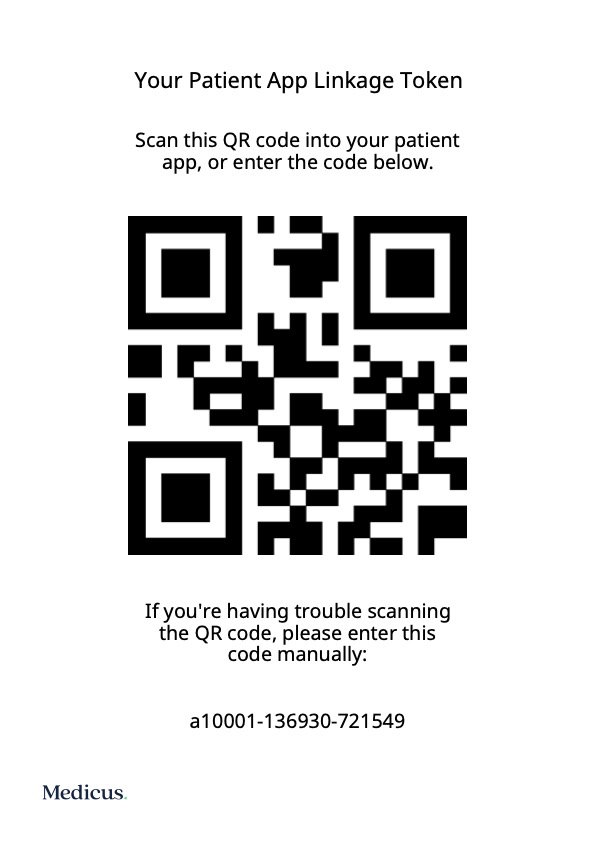Establishing a Patient App Linkage
Overview
Before a Patient Facing Application (the PFS application) can make requests on behalf of a patient via the PFS API, it required a Patient App Linkage to be established between the App’s User and the Medicus Patient.
The patient signals their intent to allow a PFS application to link with their patient record on Medicus by requesting a printed Patient App Linkage key from their healthcare organisation. The token takes the form of a Linkage Token string and a QR code representing the Patient App Linkage Token.
The Patient App Linkage Token makes the PFS app aware of:
The patient's intent to link the app with their patient record on Medicus
The Medicus Tenant ID
The Medicus Patient ID
The Status of a Patient App Linkage Token
Active - this token can be exchanged for a Patient App Linkage.
Revoked - this token has been revoked by a member of staff and cannot be exchanged for a Patient App Linkage.
Exchanged - this token has been changed for a Patient App Linkage.
Automatic Revocation of a Patient App Linkage Token
If a patient’s permanent registration at the Healthcare Organisation is ended, then any Patient App Linkage Tokens with a status of “active” will automatically be set to “revoked”.
If a patient is marked as “Deceased” then any Patient App Linkage Tokens with a status of “active” will automatically be set to “revoked”.
Patient App Linkage Token
A Patient App Linkage Token is generated by a Medicus user on behalf of a patient.
Patient App Linkage Token structure:
An example Patient App Linkage Token:
a10001-136930-721549A Medicus user will generate a printed Patient App Linkage Token in the form of a QR code which can be read by the PFS app. The token is shown in a text format underneath the QR code.

Exchanging a Linkage Token for a Patient App Linkage
In order to create a Patient App Linkage, the PFS app must make a request to the Exchange Linkage Token API endpoint.
Step 1: Requesting a One Time Passcode
Before securing a linkage, the PFS app must first make a request to send a one time passcode (OTP) to the patient or contact’s email address. This is done via the Request Linkage OTP endpoint.
Method: POST
URL: https://{{medicusTenant}}.{{medicusBaseURL}}/pfs-api/v1/request-linkage-otp
Request Headers
Header | Value | Description |
|---|---|---|
|
| The JWT token for the API Consumer. |
| UUID | A unique token that you submit as a request header. The idempotency key guarantees that only one resource will be created, regardless of how many times a request is sent to us. |
Body Parameters
Parameter | Description | Validation Rules |
|---|---|---|
| The Patient App Linkage Token | string Must be a valid linkage token |
Example Request
POST /pfs-api/v1/request-linkage-otp
Authorization: Bearer [token]
{
"linkageCode": "a10001-258037-930450"
}Response
Successful Response Body
Field | Type | Description |
|---|---|---|
| bool | Always set to |
Example Response (OK):
HTTP/1.1 200 OK
{
"success": true
}Response Codes
HTTP Code | Error Code | Scenario |
|---|---|---|
|
| Success, the OTP was generated |
|
| There was an error sending the OTP. |
|
| The linkage code has not been included as part of the request body. |
|
| The supplied linkage code is in an invalid format. |
|
| The provided linkage code does not exist in Medicus. |
Step 2: Creating an App User Linkage
After the user has received the OTP, then they must enter it into the PFS app. The PFS app must provide a user interface for the user to enter the OTP. The OTP along with the linkage token is then sent to Medicus.
If the request is successful, a linkage is created by Medicus between the app user and the patient.
Making a Request
Method: POST
URL: https://{{medicusTenant}}.{{medicusBaseURL}}/pfs-api/v1/create-account-linkage
Request Headers
Header | Value | Description |
|---|---|---|
|
| The JWT token for the API Consumer. |
| UUID | A unique token that you submit as a request header. The idempotency key guarantees that only one resource will be created, regardless of how many times a request is sent to us. |
Body Parameters
Parameter | Type | Description |
|---|---|---|
| string | The linkage key code provided by the user The key is required again in order to reference the Account. |
| string | The OTP provided by the user |
Example Request
POST /pfs-api/v1/create-account-linkage
Authorization: Bearer [token]
{
"linkageCode": "a1001-65837-58976",
"oneTimePasscode": "12345678"
}Response
Specific Response Codes
HTTP Code | Error Code | Detail |
|---|---|---|
|
| A linkage is created between the app and the patient. |
|
| An OTP has not been provided. |
|
| The supplied OTP is in an unknown, or unrecognised format. |
|
| The provided OTP has expired. |
|
| The OTP isn’t recognised. |
|
| The linkage code is in an unknown, or unrecognised format. |
|
| The linkage code has not been included as part of the request body. |
|
| The supplied linkage code is in an invalid format. |
|
| To many attempts have been made to create a linkage. Please request another OTP. |
|
| The provided linkage code does not exist in Medicus. |
|
| A linkage already exists between this Consumer app and the account. |
Example Response (OK):
HTTP/1.1 200 OK
{
"success": true
}Example Response (Association Exists Error):
HTTP/1.1 409 Conflict
Content-Type: application/json
{
"errors": [
{
"code": "ASSOCIATION_EXISTS",
"title": "Association Exists",
"detail": "A linkage already exists between this Consumer App and the Account."
}
]
}Step 3: Follow Up Requests
After a linkage is made between the app, the app user and the patient, then follow up requests can be made to any of the PFS endpoints.
Note: to make a request to an endpoint, the PFS app must be accredited by Medicus to use that endpoint.
